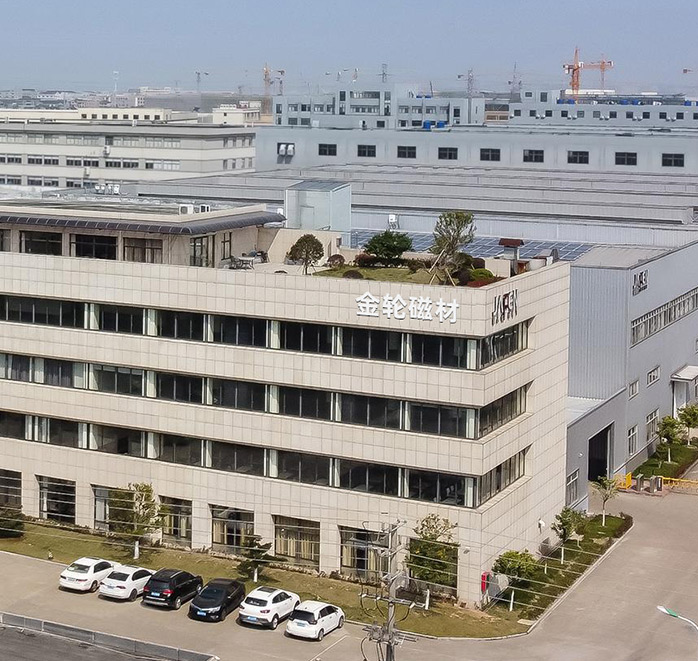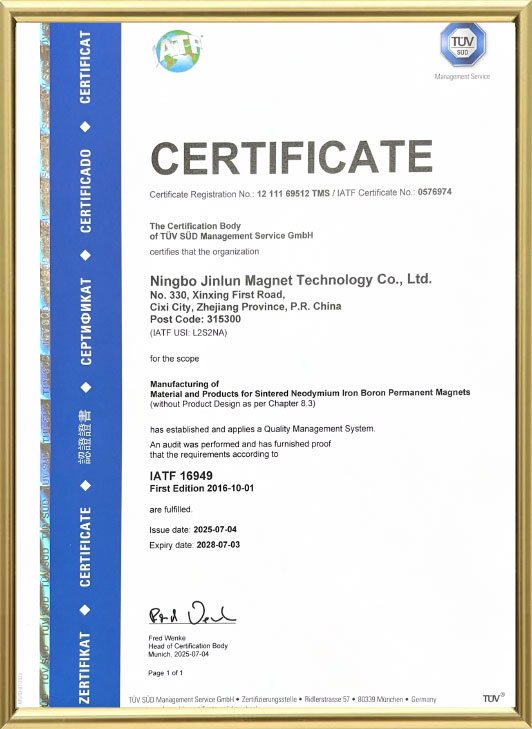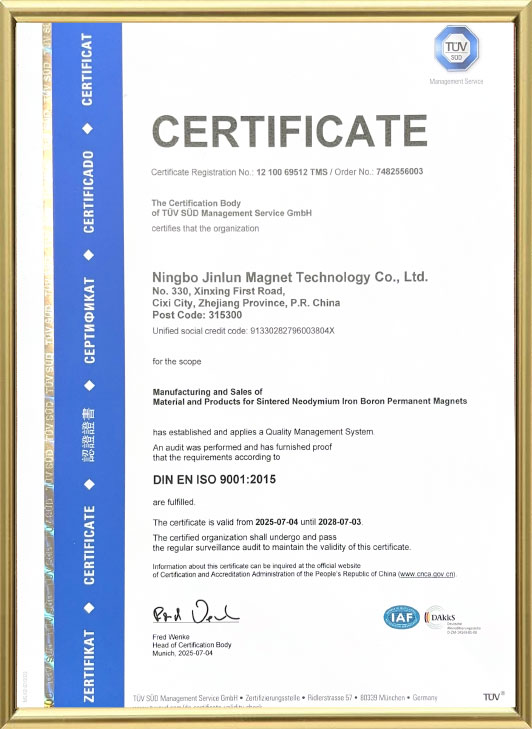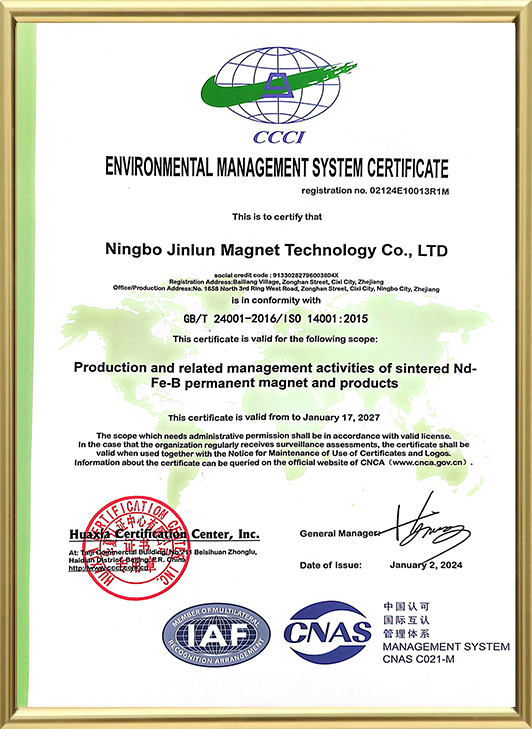I. The Core Positioning and Adaptation Logic of Sintered NdFeB Magnets for Synchronous Motors
(I) Basic Definition and Function
Sintered NdFeB Magnets for Synchronous Motors, specifically sintered NdFeB magnets for synchronous motors, are the core magnetic component of synchronous motor rotors. Their high magnetic energy product provides a stable, high-intensity permanent magnetic field, replacing traditional electrical excitation methods. This ensures that the rotor speed synchronizes with the stator's rotating magnetic field during operation, achieving efficient energy conversion. These magnets must be fully compatible with the synchronous motor's rotor structure, operating temperature, and power requirements, and are key components in determining the motor's power density, efficiency, and reliability.
(II) Adaptation Logic for Synchronous Motors
Structural Adaptation: Depending on the synchronous motor rotor design (e.g., built-in, surface-mount, or plug-in), the magnets must be customized in various shapes, such as arcs, trapezoids, and rectangles. For example, surface-mount rotors often use curved magnets, which adhere closely to the rotor surface and reduce magnetic flux leakage. Internal rotors often use rectangular or trapezoidal magnets, secured by grooves in the rotor core to improve resistance to centrifugal forces.
Performance Adaptation: Different motor powers require significantly different magnet performance requirements. Small precision synchronous motors (such as servo motors) require magnets with high coercivity (Hcj ≥ 1500kA/m) to resist demagnetization caused by armature reaction. High-power synchronous motors (such as those used in new energy vehicles) require both a high magnetic energy product ((BH) max ≥ 350kJ/m³) and high-temperature stability to ensure magnetic performance does not degrade under high loads.
Environmental Adaptation: Synchronous motors operate in diverse environments (such as industrial workshops, new energy vehicles, and aerospace) with varying temperature, humidity, and vibration conditions. Therefore, magnets require surface treatment (such as nickel-copper-nickel electroplating and epoxy coating) and composition optimization (adding dysprosium and terbium to enhance high-temperature stability) to ensure compatibility with operating temperatures ranging from -40°C to 180°C and complex environments with high dust and humidity.
II. Key Performance Indicators and Technical Requirements for Sintered NdFeB Magnets for Synchronous Motors
(I) Core Performance Indicators
Magnetic Energy Product (BH) max: This directly determines the motor's power density. Magnets used in synchronous motors driving new energy vehicles typically require a BH max of 380-450 kJ/m³. This allows for a strong magnetic field within a limited rotor volume, enabling higher power output for the same motor size. Magnets for small and medium-sized industrial synchronous motors typically have a BH max of 280-350 kJ/m³, balancing performance and cost.
Intrinsic Coercivity (Hcj): This is a key indicator of resistance to demagnetization. When a synchronous motor is operating, the stator armature reaction generates a reverse magnetic field. High Hcj magnets (such as high-temperature-grade products with Hcj ≥ 2000 kA/m) can prevent irreversible degradation of magnetic properties. For example, during motor startup or overload, high Hcj magnets maintain a stable magnetic field, ensuring continuous motor operation. Temperature stability: Measured by temperature coefficients (αBr and βHcj). Conventional synchronous motor magnets require αBr ≤ -0.12%/°C and βHcj ≤ -0.6%/°C. For high-temperature applications (such as aerospace synchronous motors), αBr must be optimized to ≤ -0.10%/°C by adding dysprosium, ensuring magnetic performance degradation is less than 10% at temperatures between 150°C and 180°C.
Magnetic uniformity: Magnetic uniformity within a batch of magnets must be controlled within ±3%. Excessive variations in magnet performance can lead to uneven magnetic field distribution in the motor rotor, causing torque fluctuations, increased motor noise, and increased energy consumption. This impact is particularly significant in precision servo synchronous motors. (II) Special Technical Requirements
Mechanical Strength: When synchronous motors rotate at high speeds (for example, new energy vehicle drive motors can reach speeds of up to 15,000 rpm), magnets must withstand enormous centrifugal forces. Therefore, magnets must possess high bending strength (≥25 MPa) and compressive strength (≥800 MPa) to prevent magnet breakage during high-speed operation.
Dimensional Accuracy: Magnet dimensional tolerances must be controlled within ±0.02 mm, especially for curved magnets, with a curvature tolerance of ≤0.01 mm. Excessive dimensional deviations can lead to uneven fit between the magnet and the rotor core, increasing magnetic flux leakage and reducing motor efficiency.
Corrosion Resistance: For use in humid and dusty industrial environments, the magnet surface must be coated with a uniform, dense protective layer. For example, a nickel-copper-nickel plating layer with a thickness of ≥15 μm must be applied. The magnets must also pass a 48-hour salt spray test (neutral salt spray, 5% NaCl solution) with no corrosion to ensure long-term stable operation.
III. Key Manufacturing Process Points for Sintered NdFeB Magnets for Synchronous Motors
(I) Customized Production Process
Composition Design and Melting: The rare earth element ratio is adjusted based on the temperature and performance requirements of the synchronous motor. For example, high-temperature-grade magnets require an increased dysprosium (Dy) content of 3-5% to improve Hcj and temperature stability; conventional-grade magnets can reduce the use of heavy rare earths to balance costs. Melting is performed in a vacuum induction furnace to ensure uniform alloy composition and prevent impurities from affecting magnetic properties.
Powdering and Magnetic Field Orientation: Hydrogen crushing (HD) combined with air jet milling is used to produce a uniform powder of 2-5μm to ensure consistent magnetic domain alignment. During the magnetic field orientation stage, the directional magnetic field direction is designed based on the magnet shape (e.g., arc-shaped or trapezoidal). For example, arc-shaped magnets require orientation along the arc tangent to ensure that the magnetic field direction aligns with the motor rotor's magnetic field requirements, thereby improving magnet utilization. Molding and Sintering: Molding methods are selected based on the rotor structure. Surface-mounted curved magnets are formed using isostatic pressing to ensure uniform density (≥7.5g/cm³); built-in rectangular magnets are molded using compression molding to improve production efficiency. The sintering temperature is controlled between 1050-1100°C, and staged holding (e.g., 1080°C for 4 hours) is used to reduce internal porosity and enhance mechanical strength.
Precision Machining and Surface Treatment: Diamond grinding wheels are used for grinding to ensure dimensional accuracy and surface finish (Ra ≤ 0.8μm). For curvature processing of curved magnets, a dedicated CNC grinder is used to ensure that curvature tolerances meet requirements. Surface treatment is selected based on the application environment. Nickel-copper-nickel electroplating is commonly used for industrial motors, while epoxy resin coating (thickness ≥ 30μm) is often used for new energy vehicle motors to ensure both corrosion resistance and insulation properties. (II) Process Difficulties and Solutions
Highly Uniform Magnetic Field Orientation: Arc-shaped magnets are prone to uneven magnetic field distribution during orientation. By optimizing the magnetic field permeability structure of the orientation mold and employing multi-pole orientation technology, the magnetic domains within the magnets are evenly aligned along the target direction, improving magnetic field uniformity.
Centrifugal Force Resistance of High-Speed Motor Magnets: Magnet density is improved by adjusting the sintering process (e.g., increasing the sintering temperature to 1100°C and extending the holding time). Chamfers (R0.2-R0.5mm) are designed at the contact area between the magnet and the rotor core to reduce stress concentration and prevent breakage during high-speed rotation.
Dimensional Accuracy Control: High-precision CNC machining equipment (e.g., a five-axis grinding machine) is used in conjunction with online dimensional inspection (laser diameter gauges), enabling real-time adjustment of machining parameters to maintain dimensional tolerances within ±0.02mm, meeting motor assembly requirements. With over 30 years of industry experience, Ningbo Jinlun Magnet Technology Co., Ltd. manufactures sintered NdFeB magnets for synchronous motors using state-of-the-art permanent magnet production equipment (such as high-precision magnetic field orientation machines and CNC arc grinders). This allows for precise control of process parameters throughout the entire process, from component melting to precision machining. For example, during the magnetic field orientation process, the company utilizes independently developed multi-pole orientation molds to maintain magnetic field uniformity within ±2% for arc-shaped magnets. Furthermore, leveraging its dedicated R&D team, the company can develop customized magnet formulations tailored to the power and temperature requirements of various synchronous motors. For example, the company provides high-Hcj (≥2200kA/m) and low-temperature-coefficient high-temperature-grade magnets for new energy vehicle drive motors, meeting the high-load requirements of these motors.
IV. Application Scenarios and Value of Sintered NdFeB Magnets for Synchronous Motors
(I) Main Application Areas
New energy vehicle drive motors: Permanent magnet synchronous motors (PMSMs), the core power source of new energy vehicles, widely utilize sintered NdFeB magnets. For example, pure electric vehicle drive motors often use surface-mount curved magnets with a (BH) max of 400-450kJ/m³, achieving a motor power density ≥4kW/kg and improving vehicle range (e.g., every 10% increase in motor efficiency can increase range by 8-10%). Ningbo Jinlun Magnet Technology Co., Ltd., a professional sintered NdFeB manufacturer, provides drive motor magnets tailored to different vehicle models. By optimizing the magnet structure to reduce magnetic leakage, it helps increase motor efficiency to over 96%.
Industrial servo synchronous motors: In precision machine tools, robotics, and other equipment, servo synchronous motors require high-precision speed and position control. Magnets must exhibit high magnetic uniformity and low torque ripple. For example, machine tool servo motors use rectangular sintered NdFeB magnets with a BH of ≥1800kA/m, ensuring positioning accuracy of ±0.001mm, meeting precision machining requirements. Wind Turbine Synchronous Motors: Permanent magnet synchronous motors for large wind turbines (over 1.5MW) utilize internal sintered NdFeB magnets with a (BH) max of ≥350kJ/m³. These motors achieve high efficiency at low wind speeds, improving power generation efficiency by 5-8% compared to traditional electrically excited motors while reducing excitation system maintenance costs.
Aerospace Synchronous Motors: Synchronous motors in the aerospace industry (such as satellite attitude control motors) have stringent requirements for magnet weight and temperature stability. They require lightweight, high-temperature-grade sintered NdFeB magnets with a density of ≤7.5g/cm³ and an Hcj decay rate of ≤5% at 180°C to ensure stable operation in extreme environments. (II) Application Value
Improving Motor Efficiency: The high magnetic energy product of sintered NdFeB magnets eliminates the need for excitation coils in synchronous motors, reducing copper and iron losses. This boosts motor efficiency to 95-98%, significantly exceeding the 85-90% of conventional electrically excited motors. This significantly reduces energy consumption, particularly in applications such as new energy vehicles and wind power generation.
Reducing Motor Size: High-power-density magnets can reduce the size of synchronous motors by 30-50% while maintaining the same power output. For example, a conventional electrically excited drive motor is approximately 20L in size, while a permanent magnet synchronous motor using sintered NdFeB magnets can be reduced to 12L, making it suitable for the compact spaces required by new energy vehicles and small industrial equipment.
Reducing Maintenance Costs: Permanent magnet synchronous motors lack excitation windings and slip rings, reducing maintenance requirements due to excitation system failures. Furthermore, sintered NdFeB magnets offer a lifespan of 10-15 years (matching the motor lifespan), reducing maintenance costs throughout the equipment's lifecycle.
 EN
EN English
English 中文简体
中文简体 русский
русский Deutsch
Deutsch 日本語
日本語 한국어
한국어



























